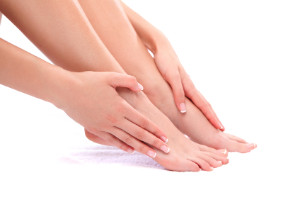

 If you begin to notice redness or dry, scaly skin around the toes, you may be suffering from Athlete’s foot. This possibility is heightened when accompanied by foul odor, which is a sign of both bacteria and fungus abrading the skin of your feet. Avoid touching the feet and then touching the rest of your body, as Athlete’s foot is communicable through contact. Moist environments should also be avoided, and be sure to wear shoes when at the gym locker room. Many over-the-counter medications are available to treat Athlete’s foot. To determine what is suitable for your case, however, it is best to consult with your podiatrist.
If you begin to notice redness or dry, scaly skin around the toes, you may be suffering from Athlete’s foot. This possibility is heightened when accompanied by foul odor, which is a sign of both bacteria and fungus abrading the skin of your feet. Avoid touching the feet and then touching the rest of your body, as Athlete’s foot is communicable through contact. Moist environments should also be avoided, and be sure to wear shoes when at the gym locker room. Many over-the-counter medications are available to treat Athlete’s foot. To determine what is suitable for your case, however, it is best to consult with your podiatrist.
Athlete’s foot is an inconvenient condition that can be easily reduced with the proper treatment. If you have any concerns about your feet and ankles, contact Dr. Alan J. Spector from Shore Podiatry. Our doctor will treat your foot and ankle needs.
Athlete’s Foot: The Sole Story
Athlete's foot, also known as tinea pedis, can be an extremely contagious foot infection. It is commonly contracted in public changing areas and bathrooms, dormitory style living quarters, around locker rooms and public swimming pools, or anywhere your feet often come into contact with other people.
Solutions to Combat Athlete’s Foot
Athlete’s foot can cause many irritating symptoms such as dry and flaking skin, itching, and redness. Some more severe symptoms can include bleeding and cracked skin, intense itching and burning, and even pain when walking. In the worst cases, Athlete’s foot can cause blistering as well. Speak to your podiatrist for a better understanding of the different causes of Athlete’s foot, as well as help in determining which treatment options are best for you.
If you have any questions please feel free to contact our office located in Point Pleasant, NJ . We offer the newest diagnostic and treatment technologies for all your foot and ankle needs.
 North Korean leader Kim Jong Un was recently seen limping in public, possibly due to his history of suffering from tarsal tunnel syndrome. The condition arises from the compression of the tibial nerve in the foot. The occurrence itself happened during a broadcasted report on the leader’s inspection visit to North Korea’s Kangwon Province. Symptoms of tarsal tunnel syndrome include a burning pain at the sole of the foot, numbness, or tingling. Treatment for tarsal tunnel syndrome may include anti-inflammatory medications and orthotics.
North Korean leader Kim Jong Un was recently seen limping in public, possibly due to his history of suffering from tarsal tunnel syndrome. The condition arises from the compression of the tibial nerve in the foot. The occurrence itself happened during a broadcasted report on the leader’s inspection visit to North Korea’s Kangwon Province. Symptoms of tarsal tunnel syndrome include a burning pain at the sole of the foot, numbness, or tingling. Treatment for tarsal tunnel syndrome may include anti-inflammatory medications and orthotics.
Tarsal tunnel syndrome can be very uncomfortable to live with. If you are experiencing tarsal tunnel syndrome, contact Dr. Alan J. Spector of Shore Podiatry. Our doctor can provide the care you need to keep you pain-free and on your feet.
Tarsal Tunnel Syndrome
Tarsal tunnel syndrome, which can also be called tibial nerve dysfunction, is an uncommon condition of misfiring peripheral nerves in the foot. The tibial nerve is the peripheral nerve in the leg responsible for sensation and movement of the foot and calf muscles. In tarsal tunnel syndrome, the tibial nerve is damaged, causing problems with movement and feeling in the foot of the affected leg.
Common Cause of Tarsal Tunnel Syndrome
The Effects of Tarsal Tunnel Syndrome
A physical exam of the leg can help identify the presence of tarsal tunnel syndrome. Medical tests, such as a nerve biopsy, are also used to diagnose the condition. Patients may receive physical therapy and prescriptive medication. In extreme cases, some may require surgery.
If you have any questions please feel free to contact our office located in Point Pleasant, NJ . We offer the newest diagnostic and treatment technologies for all your foot and ankle needs.